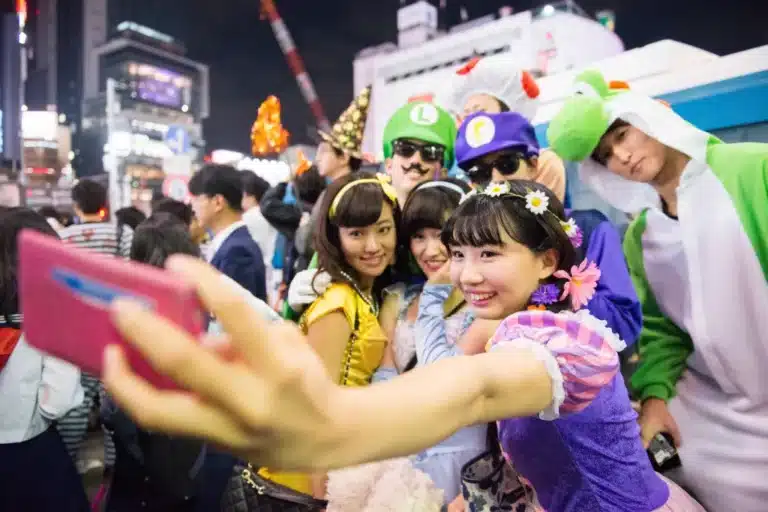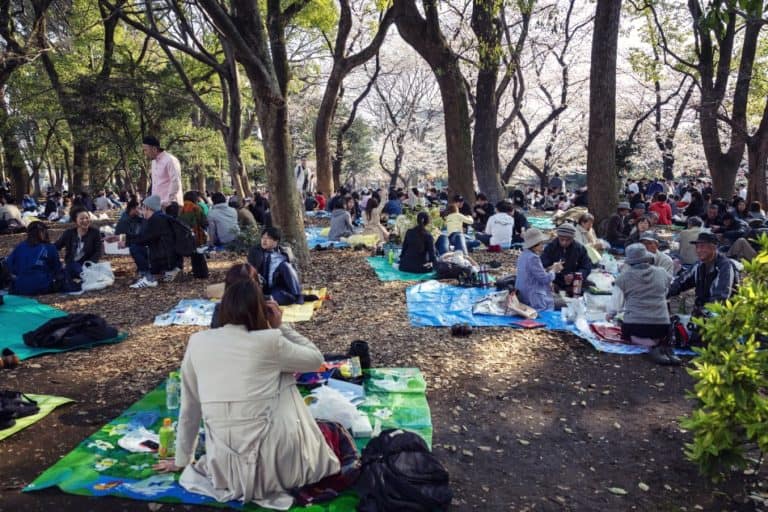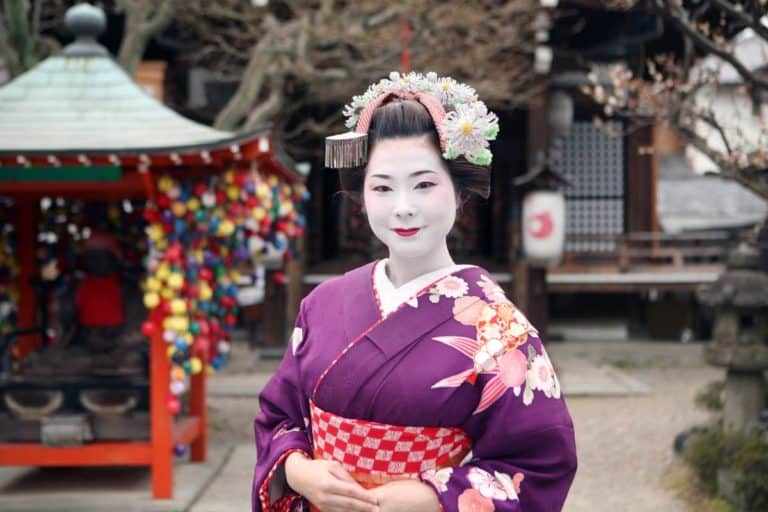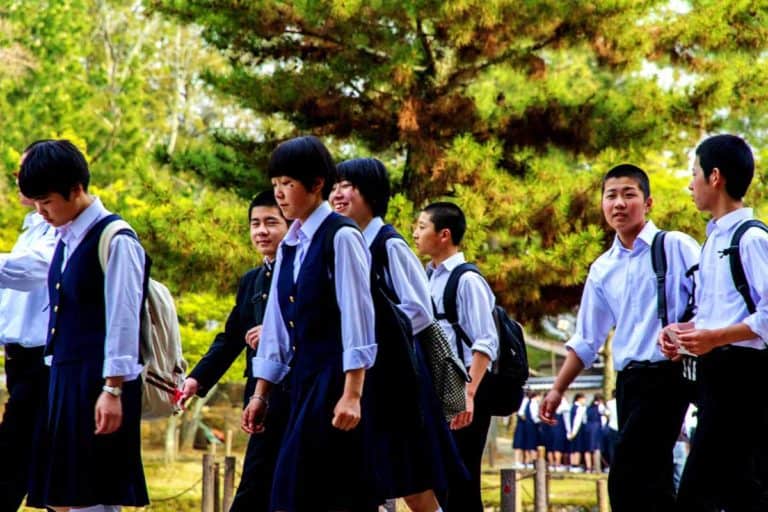10 Most Popular Festivals in Japan
We’re here to take you on a whirlwind tour of Japan’s most popular festivals.
Get ready to dive into a sea of vibrant colors, infectious beats, and mouthwatering food that will leave you craving more.
From the ethereal beauty of the Cherry Blossom Festival to the electrifying energy of Gion Matsuri, these celebrations will ignite your senses and transport you to a world where tradition meets modernity.
So grab your passport and join us as we explore the heart and soul of Japan’s cultural extravaganza.
Let’s go!
1) Cherry Blossom Festival

Are we going to the Cherry Blossom Festival this year?
The festival is a vibrant celebration of spring’s arrival and cherry blossoms blooming in Japan. It’s one of the most popular festivals in the country and attracts millions of visitors from all over the world.
The festival usually occurs in late March or early April, when the cherry blossoms are full. During this time, parks and streets are adorned with beautiful cherry blossoms, creating a picturesque and ethereal atmosphere.
People gather under the cherry trees to have picnics, enjoy traditional performances, and participate in hanami, which is appreciating the beauty of the blossoms.
It’s a truly magical experience that symbolizes the transient nature of life and the beauty of freedom.
2) Gion Matsuri

We’re excited to attend Gion Matsuri, a lively festival in Kyoto that celebrates the rich cultural heritage of Japan. This annual event is one of the most anticipated festivals in the country, attracting millions of visitors from all over the world.
As we make our way through the bustling streets, we’re enveloped in a sea of vibrant colors, the air filled with traditional music and joyful laughter.
The festival offers a unique opportunity to witness ancient traditions come to life, from the grand procession of ornate floats to the stunning displays of traditional dance and music.
The atmosphere is electric, and we can’t help but feel a sense of freedom and liberation as we immerse ourselves in this cultural extravaganza. Gion Matsuri truly embodies the spirit and essence of Japan, a celebration of freedom and the preservation of tradition.
3) Sapporo Snow Festival

Have you ever experienced a winter wonderland like no other?
The Sapporo Snow Festival is a magical event that showcases unique ice sculptures that will take your breath away. From towering castles to intricate animals, the artistry of the sculptures is genuinely mesmerizing.
Not only that, but the festival also attracts international ice-carving teams, adding a global touch to this captivating winter extravaganza.
Unique Ice Sculptures
We’ve seen many breathtaking ice sculptures at the Sapporo Snow Festival. The sheer beauty and intricacy of these frozen works of art never fail to amaze us. As we wander through the festival grounds, we’re captivated by the skill and creativity displayed in each sculpture.
The shimmering ice reflects the sunlight, creating a magical atmosphere that transports us to a winter wonderland.
The sculptures range from delicate animals and mythical creatures to towering castles and famous landmarks. Each sculpture tells a unique story, inviting us to imagine and dream.
The festival reminds us of the endless possibilities of freedom – the freedom to create, express, and be inspired. It’s a celebration of the human spirit and the power of imagination.
4) Awa Odori

Do we know the cultural significance and history of Awa Odori, one of the most popular festivals in Japan?
Awa Odori, also known as the ‘Fool’s Dance,’ dates back over 400 years and originates from Tokushima Prefecture. It’s a celebration of life, joy, and liberation. The festival’s cultural significance can be seen in its vibrant costumes, energetic dances, and lively music.
Awa Odori brings people together, fostering a sense of community and unity. The festival embodies the Japanese spirit of resilience and perseverance, continuing even during hardship and tragedy.
Awa Odori is a testament to preserving tradition and cultural heritage, showcasing Japan’s rich history and artistry.
Dance Styles and Costumes
We love the vibrant dance styles and colorful costumes of Awa Odori, which add to the festive atmosphere of this traditional Japanese celebration.
The dance styles of Awa Odori are energetic and dynamic, with performers moving in sync with the beat of traditional Japanese music.
The costumes worn during the festival are equally captivating, with bright colors and intricate designs that reflect the rich cultural heritage of Japan.
The combination of lively dance movements and eye-catching costumes creates a mesmerizing spectacle that embodies Japanese culture’s spirit.
Here is a table showcasing some of the most popular dance styles and outfits of Awa Odori:
| Dance Styles | Costumes |
|---|---|
| Ren | Happi Coat |
| Men | Yukata |
| Odori | Getta Shoes |
Whether you are participating in the dance or simply enjoying the festivities as a spectator, the dance styles and costumes of Awa Odori are sure to leave a lasting impression.
5) Tanabata Festival

We love celebrating the Tanabata Festival yearly by writing our wishes on colorful paper strips and hanging them on bamboo branches.
This vibrant festival, also known as the Star Festival, is deeply rooted in Japanese tradition and is celebrated on the 7th day of the 7th month.
The origins of Tanabata date back to a Chinese legend about two star-crossed lovers, Orihime and Hikoboshi, who are separated by the Milky Way and are only allowed to meet once a year on this special day.
During the festival, streets and shopping areas are adorned with beautiful decorations, and people gather to enjoy lively parades, traditional dances, and delicious street food.
It’s a time of joy and togetherness as we express our hopes and dreams and revel in the freedom to celebrate our desires and aspirations.
6) Nebuta Matsuri

Let’s not miss the chance to experience the vibrant energy of Nebuta Matsuri’s stunning illuminated floats and lively music. This festival, held in Aomori, Japan, is a feast for the senses that will leave you in awe.
The streets come alive as giant floats adorned with intricate paper lanterns are paraded through the city. The beats of traditional drums reverberate through the air, creating an electrifying atmosphere. As you walk among the crowds, you can’t help but be swept away by the contagious excitement.
The sight of the larger-than-life mythical creatures depicted on the floats, the hypnotic glow of the lanterns, and the rhythmic chants of the participants will fill you with a sense of wonder and joy.
Don’t miss out on this unforgettable celebration of Japanese culture and tradition.
7) Takayama Matsuri

The Takayama Matsuri is one of the most renowned festivals in Japan, known for its vibrant atmosphere and rich history.
Held in the city of Takayama in the Gifu Prefecture, this festival dates back over 300 years and is deeply rooted in the local community’s traditions and customs.
The festival showcases elaborately crafted yatai floats with intricate carvings and beautiful textiles. These floats are paraded through the streets, accompanied by the lively sounds of traditional music and performances.
The Takayama Matsuri not only serves as a celebration of the area’s cultural heritage but also as a way to bring people together, fostering a sense of unity and pride within the community.
This festival truly encapsulates the spirit of freedom and joy that the people of Takayama cherish.
Festive Traditions and Customs
During the Takayama Matsuri, we witnessed several stunning floats parading through the streets, showcasing the vibrant customs and traditions of the festival.
The atmosphere was electric, with traditional music filling the air and the streets adorned with colorful decorations.
As we watched the floats pass by, we couldn’t help but feel a sense of awe and admiration for the rich cultural heritage on display. The festival captured the spirit of freedom and celebration as people from all walks of life came together to revel in the festivities.
The lively dances, intricate costumes, and elaborate rituals transported us to a different time and place, reminding us of the importance of embracing our traditions while embracing our freedom.
8) Kanamara Matsuri

We love attending Kanamara Matsuri every year to celebrate and embrace Japan’s unique customs and traditions. This vibrant and lively festival, also known as the ‘Festival of the Steel Phallus,’ takes place in Kawasaki City, just outside Tokyo.
The festival is centered around the Kanayama Shrine, dedicated to fertility and safe childbirth. The event’s highlight is the procession of the mikoshi, or portable shrines, which are shaped like giant phalluses.
People from all walks carry these phalluses through the streets, accompanied by music, dancing, and laughter.
The festival aims to promote health awareness and celebrate all forms of love and sexuality. It’s a unique and liberating experience showcasing Japanese culture’s openness and acceptance.
9) Kanda Matsuri

During our recent trip to Tokyo, we had the opportunity to witness the grandeur of Kanda Matsuri, which takes place every two years in May. The atmosphere was electrifying as we joined the bustling crowds, eagerly anticipating the start of the festival.
Here are three things that made Kanda Matsuri an unforgettable experience:
- Vibrant Processions: The streets came alive with the rhythmic beat of drums and the melodic tunes of flutes as ornately decorated floats paraded through the city. It was a visual feast, with vibrant colors and intricate designs adorning each float.
- Traditional Performances: We were captivated by the mesmerizing performances of traditional music and dance. Geisha, samurai, and other performers showcased their skills, transporting us back to the Edo period.
- Spiritual Aura: Despite the lively atmosphere, there was an underlying sense of reverence and spirituality. The festival is deeply rooted in Shinto traditions, and we could feel the connection between the participants and their ancient beliefs.
Kanda Matsuri was an exhilarating celebration of Japanese culture, where tradition and modernity seamlessly merged, leaving us in awe of the country’s rich heritage.
10) Yuki Matsuri

The Yuki Matsuri festival features breathtaking ice sculptures and enchanting snow lanterns, creating a magical winter wonderland.
As we wander through the festival grounds, we’re immediately captivated by the intricate details of the ice sculptures.
These frozen masterpieces, meticulously carved by talented artists, showcase Japan’s rich culture and history. The sculptures range from traditional Japanese landmarks to whimsical characters, each more impressive than the last.
On the other hand, the snow lanterns emit a soft and warm glow, lighting up the night sky and adding to the enchanting atmosphere. We can’t help but feel a sense of wonder and awe as we explore this winter wonderland.
The Yuki Matsuri festival captures the essence of freedom and creativity, allowing us to escape into a world of beauty and imagination.
Frequently Asked Questions
Are Any Specific Dress Codes or Traditional Costumes Attendees Should Wear During the Cherry Blossom Festival?
There isn’t a specific dress code for the cherry blossom festival, but many attendees wear traditional Japanese clothing like kimonos or yukatas. It adds to the festive atmosphere and makes the experience more immersive.
Are Pets Allowed to Accompany Their Owners to the Gion Matsuri?
Pets are not allowed to accompany their owners to the Gion Matsuri. It’s unfortunate, but the festival organizers prioritize safety and cleanliness. However, the vibrant atmosphere and lively parade make up for this restriction.
What Are Some Unique Food and Drink Offerings Available at the Sapporo Snow Festival?
You’ll find various unique food and drink offerings at the Sapporo Snow Festival. From steaming bowls of ramen to hot mulled wine, there’s something for everyone to indulge in while enjoying the winter wonderland.
Is There a Specific Age Limit for Participating in the Awa Odori Dance Performances?
Participating in the Awa Odori dance performances is no specific age limit. People of all ages can join the festivities and dance to the lively music and traditional steps.
Are Any Special Rituals or Customs Associated With the Tanabata Festival That Visitors Should Be Aware Of?
There are several special rituals and customs associated with the Tanabata festival. It is a vibrant celebration where people write their wishes on colorful paper strips and hang them on bamboo branches.
Conclusion
As we bid farewell to the vibrant festivals of Japan, we’re left with memories that will forever warm our hearts. From the delicate beauty of the Cherry Blossom Festival to the exhilarating energy of the Awa Odori, each festival offered a unique experience that transported us to another world.
It’s a bittersweet feeling, like watching a final firework explode in a sky full of stars. But fear not, for these festivities will return, bringing joy and wonder again.






